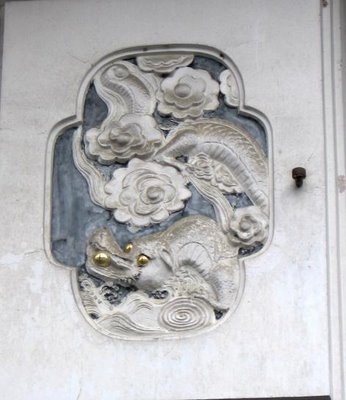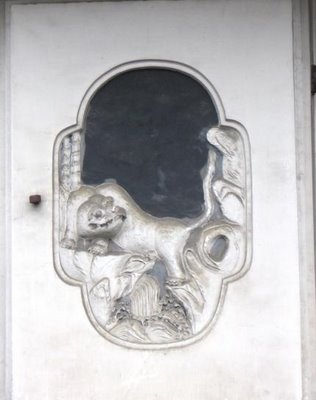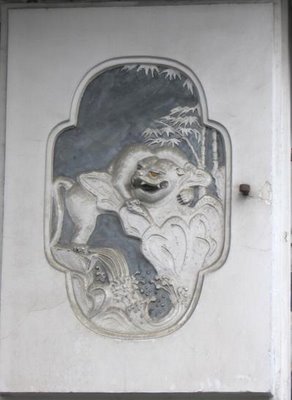. Edo shokunin 江戸職人 craftsmen, artisan, Handwerker .
:::::::::::::::::::::::::::::::::::::::::::::::::::::::::::::::::::::::::::::::::::::::::::::::::::::::::::::::::::::::::::::::::::::::::::::::::::::::::::::::::::::::::::::::::::::
shakan, sakan 左官 plasterer, stucco master
kabenuri no shokunin 壁塗りの職人 painting walls

source and more : edoichiba.jp...
kote-e 鏝絵 "painting with plaster", relief picture often as decorations on the storehouse of rich merchants.
The main work of the shakan san during the construction of a traditional home is the making of the wall
tsuchikabe 土壁 "earth wall", mud wall
local versions are
kyookabe 京壁 Kyoto Wall
Otsukabe 大津壁 wall from Otsu city
- with three variations : ・泥大津 ・並大津 ・大津磨き
keisodokabe 珪藻土壁 diatomaceous earth wall
with mud from a lake or the sea with remains of plankton and seaweed.
This wall is moisture absorbend and noise absorbent.
nurikabe 塗壁, shakan kabe 左官壁, nihon kabe 日本壁 "Japan Wall"
shikkui 漆喰 Shikui, lime plaster used for walls
- quote
Also called komaikabe 小舞壁.
A wattle and daub wall made of course mud plaster, ara-nuri 荒塗, usually mixed with straw. The daub is applied first to a framework of vertical and horizontal bamboo lath laced with rope, *komai 小舞. Then, a middle or second coat of a finer mixture of daub *nakanuri 中塗り, is applied. Finally, a top coat *uwanuri 上塗り, of either smooth white plaster or one that has a sandy finish is applied.
The surface color will differ depending on the material used. Sabikabe 錆壁 is earth colored, benikabe 紅壁 is a soft red color and jurakukabe 聚楽壁 is gray.
nakanuri 中塗り "middle layer"

Also called chuugomi 中込; nakazuke or chuuzuke 中付.
A middle layer of plaster applied between the base and finish coats of a plastered wall. If there are more than three layers of plaster it is the one directly beneath the finish coat. Its top surface is smoothed so that the final top coat can be laid without flaws. The term is also applied to a surface that receives several coats of plaster. .
- source : JAANUS

source : plumcherryume.jugem.jp
Old tsuchikabe of a traditional home - worn by time.
The final outside cover of a wall is a white, almost waterproof plaster called
shikkui 漆喰
Lime plaster used to coat walls, ceilings and earth floors *doma 土間. The word 'shikkui' is said to be derived from the Tang Chinese word for lime. Shikkui is made by combining lime with glutinous matter like funori 布海苔 and red algae tsunomata 角叉, and fibres such as hemp thread; pounding, and mixing in water. Sand and clay are also sometimes added. In wall construction, the plaster is applied to a mesh attached to and stretched between posts or pillars. Traditionally the coarsest type was the first layer to cover the mesh. Each layer was more and more refined, until the final coat had a very smooth surface.
Many walls inside stone tomb chambers *kofun 古墳 are coated with shikkui; Takamatsuzuka 高松塚 (7-8c) in Nara is particularly famous example.
- source : www.aisf.or.jp/~jaanus
:::::::::::::::::::::::::::::::::::::::::::::::::::::::::::::::::::::::::::::::::::::::::::::::::::::::::::::::::::::::::::::::::::::::::::::::::::::::::::::::::::::::::::::::::::::
- quote
Kote-e 鏝絵 kote art is a relief picture.
Basically, it is drawn on white lime plaster with a flatiron which is called "Kote" in Japanese. Kote-e art was drawn in hope of ridding ones bad luck, improving welfare of ones household and the wish to be gifted with children. Artists of them are unknown, however, their pieces of work that remained today attract many people.

Kote-e art of Hiji was popularized by Aoyagi Koichi and his son Nagaichi during the Edo period. When Koichi was studying art in Edo, Kote-e art was popular. He brought back techniques of Kote-e art to Hiji and after the restoration of imperial power in 1868, he worked to promote Kote-e art.
Koichi is one of the Kote-e artists. Kote-e is like a relief engraving picture which is drawn on lime plaster using trowel. Kote-e art were drawn from the Edo era to Meiji period. Hiji is a one of areas which has lots of Kote-e art in Oita prefecture. Koichi was born on 3rd, August 1839 as a 5th son of Waki Giichi, who was an in-house plasterer of the Hiji domain. Koichi learned the work of plastering from his father, then went to Edo (present Tokyo) to refine his skill. When Koichi stayed in Edo, he met Irie Nagahachi (1815-1889) who was the founder of Kote-e art, and Koichi learned about Kote-e from Nagahachi. After Koichi came back to Hiji, he became an in-house plasterer at the young age of 21.
- source : www.town.hiji.oita.jp
..............................................................................................................................................

- More kote-e from Kitsuki - Jake Ojisan -
..............................................................................................................................................
From the doors of a sake storehouse in Katsuyama
They were made of stucco by the local wall plasterers (shakan, sakan 左官) with very simple tools. The plasterers used to make the earth walls (tsuchikabe 土壁) of traditional Japanese houses.


On the lower doors, there are two lions:


Read my article about the town of Katsuyama 勝山, Okayama .
..............................................................................................................................................
- further reference - kote-e -
..............................................................................................................................................
Izu no Choohachi 伊豆の長八 Izu no Chohachi - Irie Choohachi 入江長八 Irie Chohachi
with his own museum in Matsuzaki 松崎
- quote
Irie Chohachi is also a legendary name as plasterer, sculptor and painter.

But, he was a real human being, lived from the end of the Edo period till the 20s of the Meiji period (1868-1912).
Chohachi was born in Matsuzaki on the west coast of Izu Peninsula in 1815 . . .
. . . he became more active since the late 1870s. He worked not only as plasterer at constructions, but as a sort of artist and started to organize exhibitions of his works in 1876. He was given a prize at the First Domestic Industrial Exhibition in 1877. In 1880 he was again back to Matsuzaki and worked for the Iwashina Shool, including the wall of cranes in the upstairs. After decades of active creation, he died in 1889.
- source : www.ocada.jp/izu/chohachi
The timber used for a kura was covered with clay and then with a plaster finish.
. kura 蔵 storehouses .
..............................................................................................................................................
. Billboard architecture 看板建築 kanban kenchiku .
Most often mortar モルタル was used, often grafted in patterns of Greek temples with impressive classical pillars and gables. Others had the look of Art Nouveau decorations. This draws heavily on the art of the shakan 左官, the wall plasterers of Edo.
:::::::::::::::::::::::::::::::::::::::::::::::::::::::::::::::::::::::::::::::::::::::::::::::::::::::::::::::::::::::::::::::::::::::::::::::::::::::::::::::::::::::::::::::::::::
. Edo shokunin 江戸職人 craftsmen, artisan, Handwerker .

Kanda Shirakabechoo 神田白壁町 Shirakabe-Cho district in Edo
lit. "white wall district".
Most plasterers lived in these two districts, 上 and 下.
The official head 棟梁 of the district was 安間源太夫 Yasuma Gendayu, who supervised and payed the plasterers working for the Bakufu government of Edo.
- - - - - famous residents of the district
. Hiraga Gennai 平賀源内 .
Painter Tamura Ransui 田村藍水 (1715 ?18 - 1776)
..............................................................................................................................................

O-Edo Shakan Matsuri 大江戸左官祭り Festival of Edo Shakan - in 2012
source : ooedosakan.iseeall.co.jp

kamado nuri, kamadonuri 竈塗り / 竃塗り repairing the earthen hearth
This was the job of a professional shakan, sakan 左官 plasterer, stucco master.
The kamado , hittsui (also called hettsui へっつい) was used every day to prepare the meals.
Usually it had two openings to fire up separately.
To put new plaster earth around the hearth as a fire protection was usually done as one of the preparations for the New Year.
竈も化粧をしたる年の暮
hittsui mo keshoo o shitaru toshi no kure
the cooking stove too
likes to have some make-up
at the end of the year
anonymous senryu
. daidokoro 台所 the Japanese kitchen .
:::::::::::::::::::::::::::::::::::::::::::::::::::::::::::::::::::::::::::::::::::::::::::::::::::::::::::::::::::::::::::::::::::::::::::::::::::::::::::::::::::::::::::::::::::::
. shokunin 職人 craftsman, craftsmen, artisan, Handwerker .
. nori 糊 starch, glue / himenori 姫糊 "princess nori glue". .
:::::::::::::::::::::::::::::::::::::::::::::::::::::::::::::::::::::::::::::::::::::::::::::::::::::::::::::::::::::::::::::::::::::::::::::::::::::::::::::::::::::::::::::::::::::
- - - - - H A I K U - - - - -
炉開きや左官老い行く鬢の霜
. robiraki ya sakan oi yuku bin no shimo .
. Matsuo Basho 松尾芭蕉 - Archives of the WKD .
:::::::::::::::::::::::::::::::::::::::::::::::::::::::::::::::::::::::::::::::::::::::::::::::::::::::::::::::::::::::::::::::::::::::::::::::::::::::::::::::::::::::::::::::::::::
- - - - - Masaoka Shiki
とろとろと左官眠るや燕
torotoro to shakan nemuru ya tsubakurame
soundly, soundly
the plasterer sleeps -
swallows
. WKD : tsubame 燕 lark .
雨乞をよそ事にいふ左官かな
amagoi o yoso goto ni iu shakan kana
the plasterer says
it is not for him,
this rain ritual . . .
If he has promised to finish work and can not continue, he might have a rain ritual to stop the rain. But no, not this time . . .
The cut marker KANA is at the end of line 3.
. WKD : amagoi 雨乞い rain rituals .
. WKD - Masaoka Shiki 正岡子規 .
..............................................................................................................................................
ふつふつと布海苔を煮るや左官妻
butsubutsu to funori o niru ya shakanzuma
she boils the funori
bubbeling and boiling -
the wife of the plasterer
Saitoo Shigeko 佐藤重子 Saito Shigeko
. WKD : funori 海蘿 / 布海苔 Funori, red algae, Gloiopeltis frucata .
..............................................................................................................................................
町内の左官屋の菊三色(みいろ)ほど
choonai no shakanya no kiku mi-iro hodo
the chrysanthemums
of the plasterer's house in town
with just three colors
Takazawa Ryoichi 高澤良一
:::::::::::::::::::::::::::::::::::::::::::::::::::::::::::::::::::::::::::::::::::::::::::::::::::::::::::::::::::::::::::::::::::::::::::::::::::::::::::::::::::::::::::::::::::::

autumn flowers ...
the white walls of
this old postal town
. Gabi Greve, visiting namakokabe walls 海鼠壁 .
Katsuyama, Okayama
:::::::::::::::::::::::::::::::::::::::::::::::::::::::::::::::::::::::::::::::::::::::::::::::::::::::::::::::::::::::::::::::::::::::::::::::::::::::::::::::::::::::::::::::::::::
. Japanese Legends - 伝説 民話 昔話 – ABC-List .
................................................................................. Aichi 愛知県
長篠の医王寺 Temple Io-Ji at Nagashino
A plasterer was walking along a mountain pass in the evening, when suddenly he felt something heavy hanging to his back.
He was quite afraid and walked on in haste. When he saw the lights of the Io-Ji temple 医王寺, the strange load on his back became light and vanished.
................................................................................. Fukushima 福島県
. ningyoo 人形 a strange doll .
kobiki 木挽職人 working with a special saw / shakan, sakan 左官職人 plasterer / seizai shokunin 製材職人 lumberjack working at a construction site
................................................................................. Miyagi 宮城県
.......................................................................
本吉町 Motoyoshi town // 壁塗りの職人
. kitsune 狐 deceived by a fox .
..............................................................................................................................................
- reference : Nichibun Yokai Database -
:::::::::::::::::::::::::::::::::::::::::::::::::::::::::::::::::::::::::::::::::::::::::::::::::::::::::::::::::::::::::::::::::::::::::::::::::::::::::::::::::::::::::::::::::::::
. Japanese Architecture - cultural keywords used in haiku .
. shokunin 職人 craftsman, craftsmen, artisan, Handwerker .
- Introduction -
. Kaido 街道 Highways - ABC Index .
. Famous Places and Powerspots of Edo 江戸の名所 .
. Edo bakufu 江戸幕府 The Edo Government .
. Doing Business in Edo - 商売 - Introduction .
. senryu, senryū 川柳 Senryu poems in Edo .
. Japanese Architecture - The Japanese Home .
. Interior Design - The Japanese Home .
. Legends and Tales from Japan 伝説 - Introduction .
::::::::::::::::::::::::::::::::::::::::::::::::::::::::::::::::::::::::::::::::::::::::::::::::::::::::::::::::::::::::::::::::::::::::::::::::::::::::::::::::::::::::::::::::::::
[ . BACK to DARUMA MUSEUM TOP . ]
[ . BACK to WORLDKIGO . TOP . ]
- #shakan #plasterer #stuccomaster #sakan #kabenuri #tsuchikabe #claywall -
:::::::::::::::::::::::::::::::::::::::::::::::::::::::::::::::::::::::::::::::::::::::::::::::::::::::::::::::::::::::::::::::::::::::::::::::::::::::::::::::::::::::::::::::::::::
3 comments:
Gofunai Henro
Nr. 80 - Chooenji 長延寺 Choen-Ji
- 太元山 Taigenzan 宇賀院 Uga-In 長延寺 Choen-Ji
港区三田4-1-31 / Minato ward, Mita 4-1-31
.
The temple has a kote-e こて絵 stucco relief painting by 今泉善吉 Imaizumi Zenkichi, a student of the famous stucco master 伊豆の長八 Izu no Chohachi.
不動明王霊夢 Fudo Myo-O Reimu and
The subject of another kote-e is
『龍図』 Dragon and 『俵藤太』Tawara no Tota.
.
https://gokurakuparadies.blogspot.jp/2017/04/gofunai-temples-80-and-81.html
.
sabikabe 錆壁
The finishing coat on a wall that consists of iron rust mixed with clay or plaster. Originally, old nails were boiled, and the resulting liquid was mixed with the clay or plaster.
Now, iron filings are used.
Folk tales have it that soy sauce was sometimes added to the rust or filings to produce a rich dark brown.
.
http://www.aisf.or.jp/~jaanus/deta/s/sabikabe.htm
.
Legend from Miyagi 宮城県, 本吉町 Motoyoshi
.
kitsune 狐 deceived by a fox 狐
A kabenuri no shokunin 壁塗りの職人 plasterer had helped a farmer with his work and was on his way home. He had gotten some tako 蛸 octopus and iwashi 鰯 sardines and put them in a charcoal bag. But when he reached home, the bag was empty.
He found some leftovers of octopus and sardines scattered at the nest of a fox - aaa, he had been deceived by a fox.
.
https://edoflourishing.blogspot.com/2020/05/shokunin-craftsmen-legends.html
.
Post a Comment